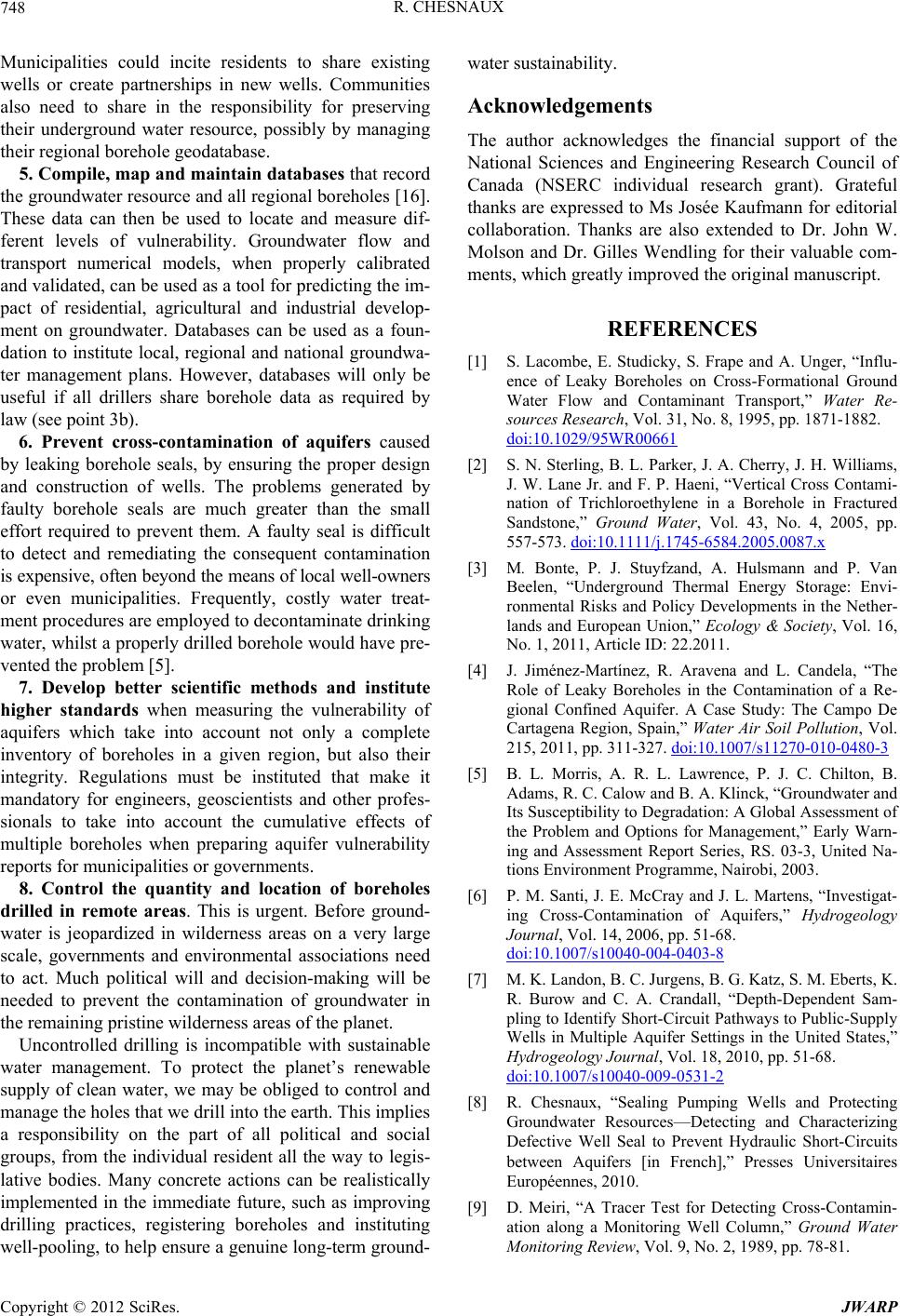
R. CHESNAUX
748
Municipalities could incite residents to share existing
wells or create partnerships in new wells. Communities
also need to share in the responsibility for preserving
their underground water resource, possibly by managing
their regional borehole geodatabase.
5. Compile, map and mainta in data bases that record
the groundwater resource and all regional boreholes [16].
These data can then be used to locate and measure dif-
ferent levels of vulnerability. Groundwater flow and
transport numerical models, when properly calibrated
and validated, can be used as a tool for predicting the im-
pact of residential, agricultural and industrial develop-
ment on groundwater. Databases can be used as a foun-
dation to institute local, regional and national groundwa-
ter management plans. However, databases will only be
useful if all drillers share borehole data as required by
law (see point 3b).
6. Prevent cross-contamination of aquifers caused
by leaking borehole seals, by ensuring the proper design
and construction of wells. The problems generated by
faulty borehole seals are much greater than the small
effort required to prevent them. A faulty seal is difficult
to detect and remediating the consequent contamination
is expensive, often beyond the means of local well-owners
or even municipalities. Frequently, costly water treat-
ment procedures are employed to decontaminate drinking
water, whilst a p roperly drilled boreh ole would have p re-
vented the problem [5].
7. Develop better scientific methods and institute
higher standards when measuring the vulnerability of
aquifers which take into account not only a complete
inventory of boreholes in a given region, but also their
integrity. Regulations must be instituted that make it
mandatory for engineers, geoscientists and other profes-
sionals to take into account the cumulative effects of
multiple boreholes when preparing aquifer vulnerability
reports for municipalities or governments.
8. Control the quantity and location of boreholes
drilled in remote areas. This is urgent. Before ground-
water is jeopardized in wilderness areas on a very large
scale, governments and environmental associations need
to act. Much political will and decision-making will be
needed to prevent the contamination of groundwater in
the remaining pristine wilderness areas of the planet.
Uncontrolled drilling is incompatible with sustainable
water management. To protect the planet’s renewable
supply of clean water, we may be obliged to control and
manage the holes that we drill into the earth. This implies
a responsibility on the part of all political and social
groups, from the individual resident all the way to legis-
lative bodies. Many concrete actions can be realistically
implemented in the immediate future, such as improving
drilling practices, registering boreholes and instituting
well-pooling, to help ensure a genuin e long-term ground-
water sustainability.
Acknowledgements
The author acknowledges the financial support of the
National Sciences and Engineering Research Council of
Canada (NSERC individual research grant). Grateful
thanks are expressed to Ms Josée Kaufmann for editorial
collaboration. Thanks are also extended to Dr. John W.
Molson and Dr. Gilles Wendling for their valuable com-
ments, which greatly improved the original manuscript.
REFERENCES
[1] S. Lacombe, E. Studicky, S. Frape and A. Unger, “Influ-
ence of Leaky Boreholes on Cross-Formational Ground
Water Flow and Contaminant Transport,” Water Re-
sources Research, Vol. 31, No. 8, 1995, pp. 1871-1882.
doi:10.1029/95WR00661
[2] S. N. Sterling, B. L. Parker, J. A. Cherry, J. H. Williams,
J. W. Lane Jr. and F. P. Haeni, “Vertical Cross Contami-
nation of Trichloroethylene in a Borehole in Fractured
Sandstone,” Ground Water, Vol. 43, No. 4, 2005, pp.
557-573. doi:10.1111/j.1745-6584.2005.0087.x
[3] M. Bonte, P. J. Stuyfzand, A. Hulsmann and P. Van
Beelen, “Underground Thermal Energy Storage: Envi-
ronmental Risks and Policy Developments in the Nether-
lands and European Union,” Ecology & Society, Vol. 16,
No. 1, 2011, Article ID: 22.2011.
[4] J. Jiménez-Martínez, R. Aravena and L. Candela, “The
Role of Leaky Boreholes in the Contamination of a Re-
gional Confined Aquifer. A Case Study: The Campo De
Cartagena Region, Spain,” Water Air Soil Pollution, Vol.
215, 2011, pp. 311-327. doi:10.1007/s11270-010-0480-3
[5] B. L. Morris, A. R. L. Lawrence, P. J. C. Chilton, B.
Adams, R. C. Calow and B. A. Klinck, “Groundwater and
Its Susceptibility to Degradation: A Global Assessment of
the Problem and Options for Management,” Early Warn-
ing and Assessment Report Series, RS. 03-3, United Na-
tions Environment Programme, Nairobi, 2003.
[6] P. M. Santi, J. E. McCray and J. L. Martens, “Investigat-
ing Cross-Contamination of Aquifers,” Hydrogeology
Journal, Vol. 14, 2006, pp. 51-68.
doi:10.1007/s10040-004-0403-8
[7] M. K. Landon, B. C. Jurgens, B. G. Katz, S. M. Eberts, K.
R. Burow and C. A. Crandall, “Depth-Dependent Sam-
pling to Identify Short-Circuit Pathways to Public-Supply
Wells in Multiple Aquifer Settings in the United States,”
Hydrogeology Journal, Vol. 18, 2010, pp. 51-68.
doi:10.1007/s10040-009-0531-2
[8] R. Chesnaux, “Sealing Pumping Wells and Protecting
Groundwater Resources—Detecting and Characterizing
Defective Well Seal to Prevent Hydraulic Short-Circuits
between Aquifers [in French],” Presses Universitaires
Européennes, 2010.
[9] D. Meiri, “A Tracer Test for Detecting Cross-Contamin-
ation along a Monitoring Well Column,” Ground Water
Monitoring Review, Vol. 9, No. 2, 1989, pp. 78-81.
Copyright © 2012 SciRes. JWARP